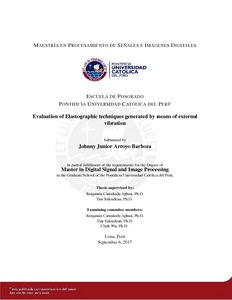| dc.contributor.advisor | Castañeda Aphan, Benjamín | |
| dc.contributor.advisor | Salcudean, Tim | |
| dc.contributor.author | Arroyo Barboza, Johnny Junior | es_ES |
| dc.date.accessioned | 2017-12-01T20:31:32Z | es_ES |
| dc.date.available | 2017-12-01T20:31:32Z | es_ES |
| dc.date.created | 2017 | es_ES |
| dc.date.issued | 2017-12-01 | es_ES |
| dc.identifier.uri | http://hdl.handle.net/20.500.12404/9821 | |
| dc.description.abstract | Breast cancer is one of the greatest problems of national and international public health, whose incidence
among women population shows an increasing trend. Nowadays there are several elastographic
techniques, which seek to characterize the tissue, that is, to analyze the response produced by the application
of a perturbation in the medium, to describe its mechanical properties. Among the modalities
used are ultrasound, nuclear magnetic resonance and optical coherence tomography. On the other hand,
among the types of disturbance used are low frequency mechanical waves, a uniform compression force
or acoustic radiation force.
In this thesis work, ultrasound was used due to its low economical cost in comparison to the other
modalities. In addition, the type of perturbation selected was the external mechanical vibration, as it
ensures the achievement of quantitative results, there is no risk of temperature rise in the analyzed area
and allows the repeatability of the results obtained. Hence, two elastographic techniques were the axes
of the present work: vibro-elastography and normal vibration holography. For the first, a calibrated
phantom and a gelatin-based phantom were used, in order to characterize and validate the technique
over a wide range of excitation frequencies. Posteriorly, 18 patients were analyzed prior biopsy exam,
obtaining elastograms and contrasting them with the respective biopsy results. The results suggest that
the technique is able to identify the presence of benign or malignant cancer, and the elasticity estimated
agree with values reported in the literature. The second technique is proposed in the elastography field
for the first time. Based on holography, its experimental scheme is established, and the mathematical
expression for shear speed estimation is presented. Results from simulation and experiments performed
on homogeneous and heterogeneous phantoms are presented, and the estimates are compared with
previously obtained reference values. The results suggest that the estimates are close to the reference
values for all media tested, and the technique must be studied in depth to revert artifacts formation. | es_ES |
| dc.description.uri | Tesis | es_ES |
| dc.language.iso | eng | es_ES |
| dc.publisher | Pontificia Universidad Católica del Perú | es_ES |
| dc.rights | Atribución-NoComercial-SinDerivadas 2.5 Perú | * |
| dc.rights | info:eu-repo/semantics/openAccess | es_ES |
| dc.rights.uri | http://creativecommons.org/licenses/by-nc-nd/2.5/pe/ | * |
| dc.subject | Holografía | es_ES |
| dc.subject | Ultrasonido--Vibración | es_ES |
| dc.subject | Ingeniería de tejidos | es_ES |
| dc.subject | Cáncer | es_ES |
| dc.title | Evaluation of Elastographic techniques generated by means of external vibration | es_ES |
| dc.type | info:eu-repo/semantics/masterThesis | es_ES |
| thesis.degree.name | Magíster en Procesamiento de Señales e Imágenes Digitales. | es_ES |
| thesis.degree.level | Maestría | es_ES |
| thesis.degree.grantor | Pontificia Universidad Católica del Perú. Escuela de Posgrado | es_ES |
| thesis.degree.discipline | Procesamiento de Señales e Imágenes Digitales | es_ES |
| renati.advisor.dni | 10791304 | |
| renati.discipline | 613077 | es_ES |
| renati.level | https://purl.org/pe-repo/renati/level#maestro | es_ES |
| renati.type | http://purl.org/pe-repo/renati/type#tesis | es_ES |
| dc.publisher.country | PE | es_ES |
| dc.subject.ocde | https://purl.org/pe-repo/ocde/ford#2.02.05 | es_ES |






